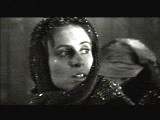

In a recent issue of Der Spiegel, Henrik Broder wrote an article discussing the americanization of the Holocaust in media and memorials, the title of which gave the cynical paraphrase: "There's no business like Shoah business."[1]The German-Jewish critic was referring to the reduction and commodification of the Holocaust in film, popular culture, and the newly established cultural institutions. This is particularly true of Holocaust film, specifically commercial films, where such reductions or miniaturizations serve the function of diversion from the gigantic cataclysm of the Nazi Genocide. By condensing and displacing this massive rupture in our history, such film often writes around precisely the most problematical aspects of both the event itself and the representation of the event.
To cite a few examples, the film version of William Styron's Sophie's Choice zooms in on the face of Sophie's daughter in the train before panning to the chimneys of Auschwitz. Her choice -- itself caught up in the binary logic of the perpetrators -- is to choose the child or lose both of her children. In Agnieska Holland's Europa, Europa (1991), the entire film gravitates around the protagonist's penis and his ability (or inability) to urinate. In Zentropa (1992), the suicide of the father is punctuated with scenes from a steamy erotic encounter of his daughter in the basement on the artificial scale of a toy train set that diminishes the real logistics of mass extermination to a toy model and eroticizes it in the process. This reduction is no less apparent in monuments and memorials; consider the little model at the United States Holocaust Memorial Museum in Washington, D.C., depicting the Jewish people actually moving into the gas chambers at Auschwitz -- which can be viewed simultaneously as a precise replica or literal depiction as well as a simplification and leveling of the complexity and differences in the event we call by euphemism alternately the Holocaust, or the Shoah, but which was in actuality the brutal murder of six million Jews.
Steven Spielberg's epic film Schindler's List (1994) is the latest installment in this americanization of the Nazi destruction of the European Jews, and it is particularly problematical precisely because, for all of its stark realism, its black and white contrast, and its unflinching look in the eye of the process of mass murder, it remains, in the final analysis, a Hollywood romance, one which allows the cathartic "machine of the visible" to do the labor of mourning or Trauerarbeit on the screen in a sentinmental and nostalgiac fashion, thus robbing the viewer of any possibility to engage in such a process of mourning herself. The condensation, convection and metonymic displacement of Schindler's List is most evident in Oskar Schindler's psychic investment in and the overdetermination of the only color image in the entire film (apart from the coerced reconciliation of the final scenes in Israel and the earlier scenes of Schindler in Krakow), that of the little girl in the red coat.

This is high capitalism, a merger, a venture arbitrage romance between Oskar Schindler, a Czech entrepreneur who became a Nazi in his quest for fame and fortune, and the Jewish population of Krakow, Poland, during the ghettoization of the Krakow Jews, the subsequent liquidation of the ghetto and their internment at a forced labor camp, and finally, the train deportations to Schindler's home town in Czechoslovakia, where he is able, through cunning, bribery, and a good deal of sheer capital investment, to establish a factory which systematically failed to produce anything for the Nazi war effort. There is a side track to Auschwitz, where the women are mistakenly taken because of some "paper-error," and where they almost perish in the gas chamber. They are miraculously saved, however, at the last moment by a paper dispatch that magically allows them a preferential treatment as opposed to a Sonderbehandlung, which meant immediate death in the gas chambers. At the decisive moment where the Zyklon B gas would, in reality, have been inserted through the holes, real water rains down upon the nakes bodies in a flood of redemption and cleansing.
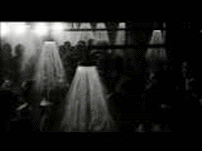
Exactly in its attempt at realistic representation, the film cleanses the Genocide of its naked horror, circumvents and euphemizes that horror in the figure of the survivor. We only get glimpses of the real fate of the European Jews as the women are leaving Auschwitz and another train arrives from somewhere else in Europe, and the Kanada Commando begins to do its real job of preparing the group for mass slaughter. In a last glimpse at the real destiny of European Jewry, a woman looks back at the chimney of the crematorium.
 |
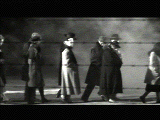 |
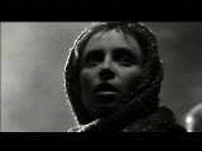 |
Even in the face of the murderer himself, Rudolf Höss, the game is exchange: Jewish diamonds as portable wealth for an escape for the Commandant, freedom from the certain death of Auschwitz for the Jews. Quid pro quo.
The film operates thus not merely with the thematics of economy, capital, investment, and high return (for Schindler and the Nazis he courts, not the Jewish people), it also operates within the metaphor or trope of the strict wiring in and internment of the viewer's articulatory power and ability to work through the visual images that saturate and ultimately wipe away the reality of the horror. It is one image in particular that condenses all of the Nazi sadism into one small pictorial area, a metonymic displacement of the mass murder of millions of people to a tiny remnant, a red coat of a small girl, one of the few color images in the entire film that bounces through the streets of Krakow until we finally see her mangled body and the red coat being carried on a small wagon as Amon Göth and his crew orchestrate the burning of the last traces of the remains of the murdered prisoners. Oskar Schindler follows this image in a visual romance until he finally sees her body, at which point his conscience is miraculously brought to life, a moral reawakening that slowly but surely changes his capitalist fantasies into a singular dedication to save as many Jews as possible.
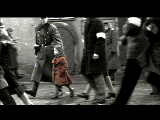 |
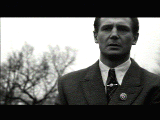 |
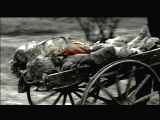 |
In this process, Schindler's List becomes an allegory: we can trace the movement of American history in the last fourteen years to a "gentler, kinder" capitalism that expresses strong emotion about the atrocities of life in this land, but which is actually somehow in collusion with them, a powerful moralism which is uncannily in step with the processes of displacement, disappropriation, and even murder itself. So Schindler's courtship of the Nazi Amon Göth reveals all of the complexity and depth of the Nazi sadist -- he shoots Jews down in the camp as if he were hunting animals in the jungle, then desperately tries to make (sexual) contact with his Jewish maid, which ends in the sadistic beating of Helen (another failed romance in this film). The Jewish people -- appropriately phrased in the genitive "Schindler's Jews" in another act of appropriation and theft -- are represented as an absolutely unified Volk. Except for one scene in which a wealthy Jewish man and his wife enter the room they are to inhabit in the ghetto, only to find that a group of Eastern European Jews will occupy this space with them -- the Eastern European Jews enter greeting them with "Shalom!" -- there are no signs of dissension among the ranks, no anti-semitism among the Jews, no fighting for bread, no quarrels between fathers and sons, no account of the reality of instinctual survival we know occured from literature, eyewitness reports, and testimony by survivors. The Jews are portrayed heroically, matching and perhaps even surpassing the heroism of Oskar Schindler. The reality of Auschwitz, however, gets lost in this narrative epic of an exemplary individual and his personal Bildung in the face of the possibility of the loss of his workforce.
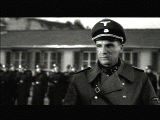
The Nazi figure of the film Amon Göth deserves careful consideration in his own right because his sexual psychopathology -- one moment he is romancing his girlfriend in his villa or flirting with his Jewish "maid," the next arbitrarily gunning down Jewish women from his terrace -- contradicts everything we have learned about Nazism since the publication of Hannah Arendt's Eichmann in Jerusalem(1963); that the SS were not, by and large, psychopathic sadists. To pathologize Göth as Sadist, to demonize him and make him a monster is precisely to miss the most disturbing knowledge we now have of the average Nazi perpetrator: that he was, in an overwelming majority of the cases, not a sadist, a "deviant" or an "aberation," but rather a dutiful, law respecting civil servant carrying out his orders. Zygmunt Bauman has persuasively argued concerning the Nazi Genocide that it is precisely this fact -- that most of the perpetrators of these crimes against humanity would be considered "normal" and would have passed tests administered to our own police officers -- that poses the real challenge to our advanced form of society and the scientific disciplines which attempt to understand it.[2] And Christopher Browning's work on Police Battalion 101 has shown that approximately 85% of the "ordinary" men assigned to carry out these grisly crimes were fully prepared to do so.[3] To make Göth into a monster, to place him so far off the spectrum of humanity is once again to displace the horror of the crime, to relegate it to the abnormal and the pathological, to ban it to an arena outside of humanity so that we do not have to confront Nazism as "the banality of evil."
The mourning process in this film is usurped by the hero, who accomplishes the necessary labor in the minutes before he flees the allied forces. He is, strictly speaking, a war criminal. He is given a letter of recommendation by Isaac Stern, his manager and collaborator in the Emailfabrikenwerk, the genius behind the merger, the bookkeeper, the foreman, the coordinator of the entire operation without whom Schindler would never have been able to create his slave labor empire. In this scene, which seeks to manipulate and control the emotional response of the viewer by pretending a real catharsis, even an apotheosis -- Schindler grasps a ring made for him by the Jews and cries "I could have saved more, one more Jew, two more Jews" -- the Trauerarbeit is all carried out on screen, as spectacle and theater, in a mass ritual intended to cleanse us of any remaining sense and emotion we may have in our desire to work through this event that questions all of our assumptions about capitalism, modernism, and representation itself.
This final metonymic reduction of the fate of the Jews to a ring, or the Nazi pin Schindler wears, runs parallel to the condensation of Auschwitz to a little red coat. The spectacle is supposed to show the horrifying internal conflict of Schindler, the inner failure of this moral Bildungsroman. What it shows, however, is the film's own failure, its captivity in the convention of Hollywood romance, false catharsis, spectacle, coerced reconcilation with the past, or what Adorno refers to as erpresste Versöhnung. This is nowehere more evident than in the final scenes, where the real survivors and their children merge with Schindler's widow in a magical "melting of horizons" which, however, elides the historical gap or rupture that continues to reverberate in our own history. We can only identify with Spielberg's film by investing in the representational scheme that has been prescribed by Hollywood, which is nothing other than specular, spectacular representation itself and which, one could argue, the Nazis utilized themselves in the construction of a premodern fantasy of blood and earth.[4]
With regard to the specularity and spectacular nature of Nazi myth itself, some quotes from Lacoue-Labarthe and Nancy's decisive article "The Nazi Myth" (reference footnote 4) are especially illuminating:
"The race, the people, is linked to blood, not to language. This affirmation is repeated ceaselessly by Rosenberg and Hitler: blood and soil -- Blut und Boden. [...]The myth called on by the tradition is often identified with muthos as the original language, as opposed to logos. Here, on the contrary, myth in some sense becomes blood, and the soil from which that blood ultimately springs."(308)
"The soul, or the "personality," or the "genius," finding itself in itself as its own most proper "myth," or, again, the soul engendering itself from its own dream, is finally nothing more than the absolute, self-creating Subject, a subject whose essential property is not solely cognitive (like the subject of Descartes), nor solely spiritual (Eckehart), nor solely speculative (Hegel), but which somehow groups together and transcends all these determinations in an immediate and absolutely "natural" essence: that of blood and race."(310)
In the sense that this representation simultaneously maintains the unity, integrity, and relative autonomy of this world of Schindler's Jews, and, under the sign of the exemplary individual who rises above the murderous everyday at the moment he fuels its very engine, identifies these Jews as the Jews, it utterly fails in representing the actual Holocaust, which, regardless of the number and kinds of narratives it evokes, or the types of description it is placed under, was not a romance, and not an allegory about modern heroism against all odds.
In the final frames, we see the actors with their real-life counterparts, past and present, contemporary reality and history in an epic fusion of horizons that blurs the boundaries that separate us from the unspeakable that we cannot not speak about, that we never cease speaking about, the "unpresentable" that we continually give witness to in phrasing Auschwitz, thereby breaking the silence, as Lyotard would say.[5] In this Verblendung, in this obliteration of the distinction between reality and fiction, history and the present, history and reality are taken up into the ideal sphere of a community somehow disengaged from the event itself, an island of comfort, reassurance, and affirmation that seeks to insure continuity and theodicy, the Aufhebung or elevation and ellision of any true loss, any real depletion of the cultural capital. Only in the isolated letters that appear on the screen after this last haunting coerced integration of the historical alterity of the Mass Murder -- "This film is dedicated to the memory of six million Jews who dies" -- does the event announce itself, inscribed as an epitaph, as a death sentence to the memory of those that in fact died, the other transport, the little girl in the red coat.
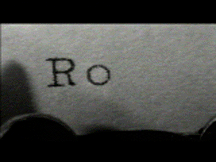
Under what listing should I try to grasp the maneuvers of Schindler's List? Does the list itself indicate a series or an accumulation of data that I can simply no longer process either as an individual or as a member of a culture? Do the eight hundred some-odd proper names give me the concrete, the palpable, the utterly individual and corporeal story of the survivor? No. Just the opposite. What we see is what the list literally tells us -- the unmediated universal, the living legacy, the sheer numerical power of the typed names. These names -- Pfefferberg, Rosen, Stern -- are, one would assume, to offer us a reliable handle on the specific ways in which the Nazi Mass Murder affected individual human lives. The film, however, does the exact opposite. The list is fetishized as such, not least in the advertisement for the film, where the list itself stands in proxy for the real individuals. The romance between Jewish capital and Nazi collaborators, between heroic individual and the machine of genocide, between real history and present fiction defines a medium that erases at every point its own collusion with the very sentimental, nostalgiac, and fascist response system -- unified, homogeneous, gleichgeschaltet -- that made the genocide of the European Jews possible in the first place.
In the United States Holocaust Memorial Museum in Washington, D.C., we see a Hollerith machine. The first punch-card tabulator that was to become the prototype of the computer, the machine enabled the Nazis a precise bureacratic reign over the population they were going to destroy. The "list" in Spielberg's Schindler's List was physically written by a typewriter, the print feverishly inscribed onto paper, one of the chief bureacratic media of the Holocaust with its orders, declarations, commands, and announcements. On another level, it is precisely the "list" itself that plays such an important role in the summoning, displacement, deportation and murder of the European Jews. It could have just as well been written by another writing machine, another writing medium of the Holocaust this tabulator by Hermann Hollerith. This haunting proximity between Stern's list for Schindler and the Nazi's endless lists of the Jews, their bureacratic obsessive character, alerts us to one of the central dangers of romancing the Holocaust: we forget that our own media technologies were fatally implicated in the process of mass extermination. From the music blasted through the loudspeakers at the selections to the films circulated for purposes of propaganda, this was above all a technological war against the Jews. And just as the image burns away at the moment of the impact of the rocket in Pynchon's Gravity's Rainbow, or as the laser directed smart-bomb utlimately destroys its imaged target, the "real" event is exploded in its cinematic displacement. [6] And this is why, I would conjecture, the people emerge silent from Schindler's List; not because it has induced a contemplation and called out for a process of thinking and working-through, but because the viewer is emptied of any real experience of what the Holocaust might have been, the capacity to think and work through blasted by the projections of this projection screen of romance. For what we get is the form, the poetic rendition of a materiality that defies the image and the description. As romance, Schindler's List symbolically fixes the Holocaust in such a way as to silence that recalcitrant materiality that, despite the image, threatens to dissolve in the identificatory projections and fantasies of the romance voyeur.
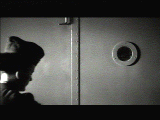
In the era of the technical reproducibility of mass murder, we need to be particularly skeptical of commercial attempts to cash in on realism. Hans Jürgen Syberberg's Our Hitler, for all of its indulgence in and possible collusion with German mystical Romanticism, has suggestively presented the Genocide as a film, a black studio in which all of the projective powers of the camera converged in the identification and expulsion of the Jewish people. Cinema, which, as a medium, has the power to "explode" the realistic "scene" in order to show the catastrophe as such, not in any nicely defined, nostalgiacally redeemed and sentimentalized manner, has arrived at the point where documentary is cast aside in favor of eyewitness testimony and witnessing. Lanzmann's Shoah does not seek to tell us, in a historicist narrative, "wie as eigentlich gewesen," but what the Nazi Genocide is now in the present and, as a document for the future, as the ongoing necessity of bearing witness. The narrativization of the Holocaust in the form of a Romance as it is performed in Schindler's List is not merely another method of denial and disavowal; it stylizes the historical reality for the sake of making it palatable, accessible, and "black and white" for the mass audience. In other words, it is culture entertainment for the masses; as such it invokes in the critical reader all of the concerns of the fascination with Fascism, voyeuristic sadomasochism and the alliance of kitsch and death that have been brought to our attention by Susan Sonntag, Irving Howe, and Saul Friedländer.[7]
Schindler's List is an important cinematic event, for it does mark the first explicit, self-conscious portrayal of the Holocaust in a major Hollywood film. Is it possible to read the critique I have given as already inscribed in the film to some extent? I believe it is. Oskar Schindler takes the apartment of a Jewish family that is relocated to a crowded dwelling in the Ghetto. The color images of the film contrast with the harsh black and white footage that begins with the escalation of the war against the Jews. The key color image of the little girl marks the eclipse of humanity, and Schindler, the voyeur who witnesses the liquidation of the Ghetto from a hill, stands as a powerful reminder of the bystanders who looked on as the Nazi Genocide of the Jews proceeded. Finally, it is possible to grasp the implications of the making of the film itself when we remember that Spielberg had wanted to film at Auschwitz, but was convinced by the World Jewish Organization among others of the inappropriateness of such action; one cannot make film where Jewish people are buried. While we must acknowledge the educational function Schindler's List serves for a society that is only remotely aware of the Nazi Genocide in its bureaucratic perniciousness and technological bestiality, we have an obligation to articulate where the film falls into accepted conventions of narrative and representation, where it colludes with the logic of reduction, condensation, compression, concentration and "leveling" that are the trademarks of Fascism itself.[8] It is only by critically rephrasing these conventions and their apparent "necessity" as the underlying rule-governing system of representations of the Nazi Genocide that we can begin to engage in the difficult and painful task of working through our own complicity in the Churban.